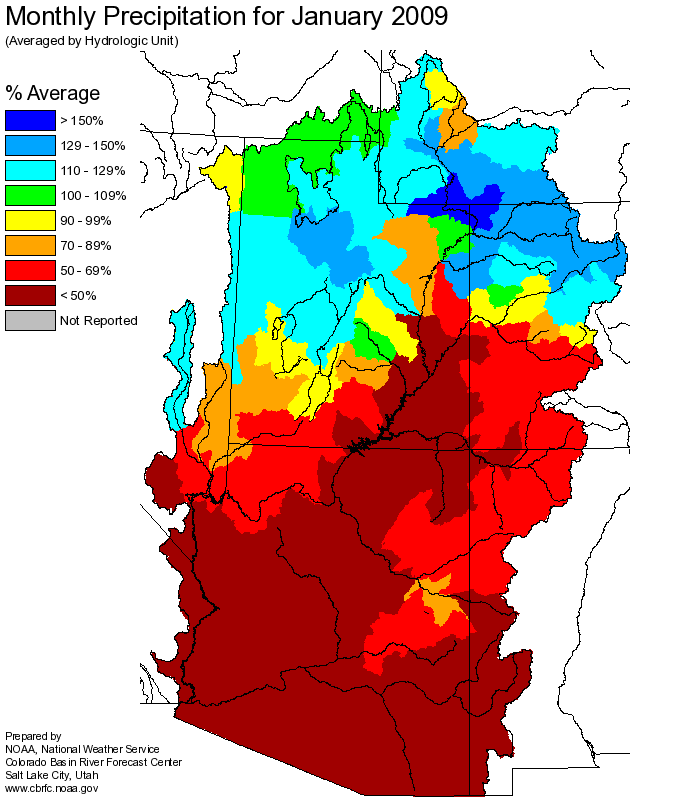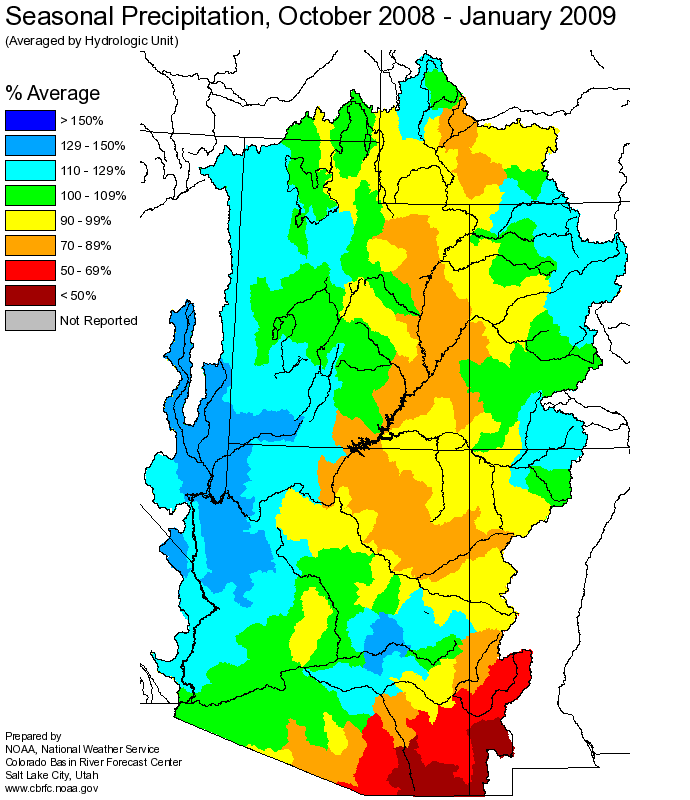Note: This publication is currently undergoing major revisions. The current publication will be replaced with a new publication based on stakeholder requirements and scientific advances. We expect to begin sharing details on this soon. If you have input on content, format, or publication frequency at any time, please contact us at cbrfc.webmasters@noaa.gov.Great Basin Water Supply Outlook, February 1, 2009Great Basin Water Supply Outlook, February 1, 2009
Contents
Great Basin Summary
Snow Water Equivalent & Precipitation -
January precipitation in the Great Basin was above average at 119%.. Snow conditions throughout the northern basin improved
slightly (5%-10%) with
indexed snow totals of 95% in the Weber and Ogden basins, 96% in the Provo
basin, 92% in the Bear River basin and 105% in the Six Creeks basin. Seasonal precipitation for the Great Basin
Salt Lake Basin was 106% of average and overall snow water equivalents are 94% of average.
Soil Moisture & Streamflow -
Soil
moisture grids from our
ESP model remain below to much below average in all headwater regions, which tends
to lower April through July volume forecasts. Currently we have no gridded information in the Bear River drainage.
Streamflows for selected points in each of the Great Basins 4 main drainages were 86% of average.
Short Term Precipitation Forecasts -
Weather guidance from
National Weather Service models are predicting wet conditions during the first 5-10 days with several
storms for both northern and southern Utah. Short term
CPC guidance
shows the possibility of above average precipitation for the second week of February.
General Discussion -
Longer range predictions from NOAA's Climate Prediction Center are now factoring in a weak
La Nina
episode, predicted to last through the spring of 2009. Please reference the web link above
for further details and effects within the Great Basin.
Volumetric forecasts were largely unchanged in the Bear River Basin with the median forecast being 85% of average.
In the Weber, Provo and Six Creeks drainages, forecasts remained within 5% of their January 1st numbers at or near
average.

*Median of forecasts within each basin.
Bear Basin Conditions
Snow Water Equivalent & Precipitation -
Snow Water Equivalent and precipitation conditions in the Bear River drainage improved slightly during January. Monthly
precipitation was 109% of average and
snow
water equivalent increased to 92% of average. Seasonal precipitation is currently 101% of average.
Soil Moisture & Streamflow -
We currently have no modelled soil moisture information for the Bear River. Observed streamflows for January
were estimated for Bear at the UT/WY State line at 86% of average. Observed flows on the Logan River nr Logan above
State Dam were 86% of average.
Short Term Precipitation Forecasts -
Short term weather service models are indicating a period wet weather during the next 8-10 days in the Great Basin region.
Short term
CPC guidance shows the possibility of above average precipitation and
below normal temperatures for the second week of February.
General Discussion -
Volumetric forecast for April through July were held steady or raised slightly ranging from 54% at Bear nr Montpelier
to 86% of average at the Utah, Wyoming State line.

* Percent usable capacity, not percent average contents.
Click for multi-month Graph.
Weber Basin Conditions
Snow Water Equivalent and precipitation -
Conditions in the Weber and Ogden River River basins were above average for January 2009. Monthly
precipiation totalled 125% of average.
Snow
water equivalent numbers rose by 5% to end the month at 95% of average. Seasonal precipiation is currently 99% of average.
Soil Moisture & Streamflow -
Soil moisture conditions were below average in the upper Weber basin during January, varying between 70-89% of average. Observed streamflows for the month
were 87% of average for the Weber at Oakley.
Short Term Precipitation Forecasts -
Short term weather service models are indicating a period wet weather during the next 8-10 days in the Great Basin region.
Short term
CPC guidance shows the possibility of above average precipitation and
below normal temperatures for the second week of February.
General Discussion -
Volumetric forecast in the Weber were all raise slightly due to the overall improvement in snow and precipitation
conditions ranging from 89% at Echo Reservoir to 94% at East Canyon Reservoir.

* Percent usable capacity, not percent average contents.
Click for multi-month Graph.
Six Creeks Basin Conditions
Snow Water Equivalent & Precipitation -
Snow Water Equivalent and precipitation conditions in the Six Creeks basins improved the most of any of the Great Basin
Salt Lake region basins during January. Monthly precipitation totalled 140% of average and
snow water equivalent
increased to 105% of average. Seasonal precipitation now totals 114% of average.
Soil Moisture & Streamflow -
Streamflows in Big and Little Cottonwood Canyons were 67% of average. These flow numbers are indicative of the
low soil moisture conditions that prevail along the Wasatch front. Soil moisture grids currently range from
50%-90% of average.
Short Term Precipitation Forecasts -
Short term weather service models are indicating a period wet weather during the next 8-10 days in the Great Basin region.
Short term
CPC guidance shows the possibility of above average precipitation for the second week of February.
General Discussion -
Volumetric forecast were raise slightly for all points in the Six Creeks basin due to the increase in SWE
and monthly precipitation. Forecast now range from 87% at Emigration Creek near Salt Lake City to 98% at Little
Cottonwood Canyon near Salt Lake City.

* Percent usable capacity, not percent average contents.
Click for multi-month Graph.
Utah Lake Basin Conditions
Snow Water Equivalent & Precipitation -
Snow Water Equivalent and precipitation conditions in the Utah Lake drainages improved during January. Monthly precipiation
totalled 131% and
snow
water equivalent numbers increased to 96% of average. Seasonal precipitation now totals 106% of
average.
Soil Moisture & Streamflow -
Streamflows for Spanish Fork near Castilla and Provo at Woodland combined were 105% of average. These
are the best streamflow number in the group of basins and are indicative of the warm, liquid precipitation event
that occured at the end of the month. Soil moisture grids along the Provo River range from 50-90 percent of
average. The Spanish Fork drainage ranges from 70%-99% of average.
Short Term Precipitation Forecasts -
Short term weather service models are indicating a period wet weather during the next 8-10 days in the Great Basin region.
Short term
CPC guidance shows the possibility
of above average precipitation for the second week of February.
General Discussion -
Volumetric forecast for Utah Lake and associated rivers were raised this month due to the improvement in
overall conditions. Forecast now range from 90% at Provo near Hailstone to 94% at American Fork near the UP
Power Plant.

* Percent usable capacity, not percent average contents.
Click for multi-month Graph.
Differences between the full period forecasts and the residual forecasts may not exactly equal the actual observed volumes due to rounding conventions (see Definitions section).
Precipitation Maps


Hydrologist: Brent Bernard








